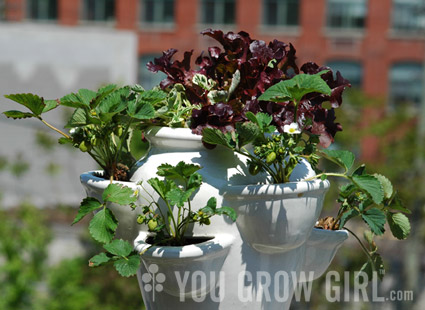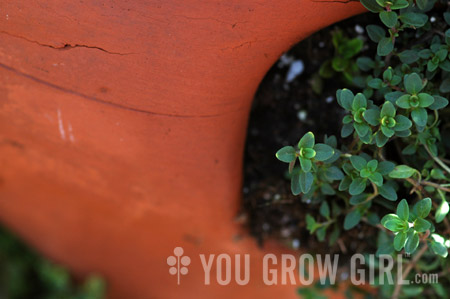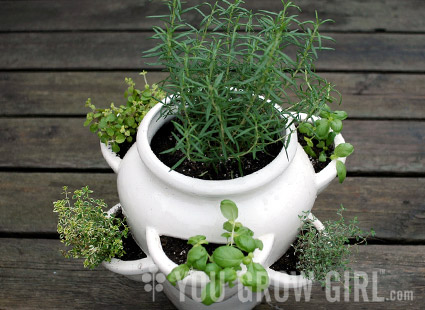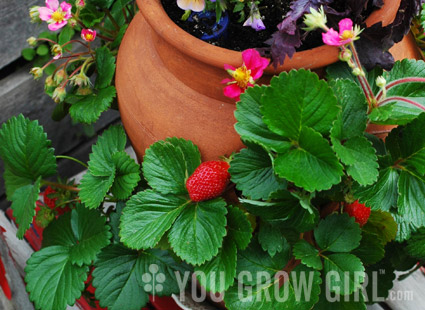
Strawberry pots have a bad reputation in the gardening world. They have poor water distribution and tend to dry out quickly. Sometimes they’re ugly. Or the pockets are too small. Or the pockets don’t have a lip, making holding soil in at planting time nearly impossible. The good ones are expensive to buy, if you can find one. I once spent an inordinate amount of money taxiing around the city in search of the right pot for a workshop. Three inferior pots and more money than I care to think about later and I was eventually forced to call a friend and beg to borrow hers. Is it borrowing if you never give it back? And four years have passed?
Despite their faults, I’ll be the first to stand up for strawberry pots. When they’re good, they’re really good. A good strawberry pot is an excellent way to grow food in vertical space. It’s especially useful when all you’ve got in the way of good light is a tiny patch on the balcony. Growing vertically allows you to get as much as you can out of that tiny patch. And they look pretty darn nice too. I like to fill mine with drapey plants that cascade over the sides. The trick to using them is in choosing the right kind of pot, and the right plants for that pot.
So what features qualify a strawberry pot as good?
- Large Pockets: Big pockets make planting the pots up a whole lot easier. Anything under 3″ is impossible to work with. How do they expect us to shove roots through a tiny hole? And why do I feel so dirty typing that? The lip also supports the roots while the plant gets itself established and provides more root space between plants. Lipped pots are also easier to water since the water has time to soak in rather than running straight out of the holes. When watering these pots I often direct the flow to the top of the pot and then to each pocket individually. That way I know that the plants aren’t sitting there in dry soil while only the top and middle of the pot gets wet.
- Pockets with Lips: Lipped pockets have a slightly raised side that keeps soil in while the roots grow. Eventually the roots will develop and hold everything in. My trick for pots with lips is to shove a bit of coir liner in there to stabilize the soil. I’ve also covered the hole with landscape fabric or newspaper before adding soil. Then I just cut an X and poke the roots through. It’s a bit of a juggle but it works.

The pockets on this pot do not have lips but it makes up for it in larger pockets and a larger pot size.
- Ceramic Pots: Ceramic pots are the best of the bunch. They’re also the most expensive, but worth it. They hold water better than terra cotta and look a whole lot classier than plastic.

My favourite strawberry pot (the infamous “borrowed pot”). Note the ceramic glaze, and large pockets with big lips that are staggered around the circumference of the pot. This version, planted up several years ago is holding the classic herbal mix with the largest plant, rosemary, in the top. Now, if only the pot were not white. I hate white!
- Staggered Pockets: Most pots have pockets that are staggered around the pot at different levels so that plants are equally distributed around the pot and not sharing space. But I have one pot that is shallow with pockets that are all at the same level. When I pot it up, which is basically never, the plants grow crowded and compete for space. Bad design.
- Big Pots: Bigger strawberry pots stay wet longer and provide more root space for plants. This is especially important if you’re trying to grow something edible. Don’t bother messing with those little pots they’ve got in the impulse buy section of the garden centre unless you plan to use them for drought tolerant succulents or some small thyme plants. That said, I have been hunting for a simple, small pot for years with no luck. But I plan to grow thyme in it.
What plants work best in strawberry pots?

Well, strawberries for one. I grow a strawberry-filled strawberry pot every year. The roots are small and fit easily into just about any sized pot. If you’re interested in trying something new, look for varieties with colourful flowers (pink is common) or variegated leaves.
Herbs are another good option. Stick to drought tolerant herbs such as thyme, oregano, or marjoram if you’re growing in a smaller pot. Big pots can support a wide assortment of herbs. I grow a different mix every year, starting with cool season plants early in the spring and then switching them out for tougher, heat-loving plants that can take a bit of neglect once the summer kicks in. One of my favourite pots stick to one type of herb with a different variety in each pocket. I grew a mint mix last year that was stunning once the plants started to trail and produce flowers. It was nice to have so many different varieties of mint on hand to pinch off for tea.
Lettuce and other assorted greens will grow well if you start your pot early in the spring while the temperatures are cool. Create visual interest by growing varieties with different shapes, colours, and textures in each pocket. The pot show at the top of this page is filled with strawberries with a dark, frilly ‘Red Oak Leaf’ lettuce in the top.
I’ve included a printable list that will help you get started in choosing the right plant for your conditions as well as herbal mixes that will grow well together.
The Famous Watering Trick, Modified
As mentioned above, strawberry pots are known for having water distribution problems. One trick many gardeners have turned to is to insert a piece of PVC pipe with tiny holes drilled throughout, down into the centre of the pot at planting time. When you pour water into the pipe, the water flows down and trickles through the holes, allowing water to reach all nooks and crannies in the pot.
It’s a good idea, but it does not come without problems:
- PVC pipes cost money.
- PVC isn’t a particularly safe plastic to have around food.
To avoid these problems, I’ve been utilizing my own modified version that has served me well for several years:
- Scour recycling bins for plastic water bottles that are long, tall, and thin. Look for a bottle that is nearly as tall as your pot.
- Using the tiniest drill bit you can find, make lots of holes all around the bottle.
- At planting time, bury the bottle in the centre of the pot, with the top just sticking up above the soil line. Try to hide it behind some foliage.
- When watering, direct the flow into the bottle and fill. Now, cap it off. Capping the bottle seems to restrict the flow, giving the entire pot the chance to soak up the water, instead of sending it straight down to the bottom of the pot.
I enjoyed your article. I love strawberry pots, but find them difficult to grow in. Thanks for sharing, will try your ideas. Plus, you have lovely pictures!
I have a number of strawberry pots filled with – what else – strawberries! So far they are doing well and producing lots of berries!
An alternative for the water distribution trick: roll some wire mesh into a tube and fill it with rocks.
Excellent tip Susan!
Hi Gayla, If you go to farmcity.ca there is a wonderful item called a strawberry condo. I went to a workshop held by an amazing woman called Seaton, and she makes these and tells others how as well. These condos are great for a balcony or any small space where you have more vertical area. Anyway, check it out. I like them as they are made of cedar and therefore do not break in the cold like a terracotta pot.
Fantastic tips! I never would have guessed a strawberry pot would have such challenges. Now I know what to look out for. Thanks!
nice read! good suggestions.
I think I need to hunt down a strawberry pot now… Yum! Your photos here are gorgeous Gayla! I really like the last one – beautifully delicious!
Great tips. In some of my barely lippy strawberry pots, I’ve inserted alpines such as hens and chicks into the holes. Use a fairly gritty soil, and plant something relatively drought-tolerant and drapey in the main plant area (such as portulaca).
How about putting in a self-watering container insert? I think it might address the drying out issues.
The ones I want are from Gardener’s Supply (http://tinyurl.com/kk4fyo), but they don’t ship to Canada. :( So I’m on the hunt for a supplier in Canada.
Thanks for the great read! I have a strawberry pot that needs some new plants and now I’m inspired.
Thanks a lot! This is just the information I missed in all the books.
What do you think about the so-called “Strawberry Patio Planters” made of polyethylene (e. g. by a firm called Haxnicks from the UK)? I’ve got some for tomatoes and lettuce and they seem to work fine… but I am quite sceptical about the pockets…
I’ve never had much success with these either.
Hi!
This instructables shows how to distribute the water in the planter without being afraid of leaving dry spots. It worked in iraqi desert, so it would work pretty much everywhere. The autor used parachute cord, widely available in a military base, but also possible to find from paragliders. Hope it helps!
http://www.instructables.com/id/How_to_grow_flowers_on_a_military_base_in_Iraq/
Hi Gayla! I enjoy your blog. Thats a great idea with the pipe. Do you think bamboo would be a good alternative? It grows wild close to my house and would seem safer than the plastic.
I have one strawberry pot, but I have always used it for succulents. I bring it inside when it gets cold. It’s a great way to display a few different variety and looks great on the deck table in the summer.
I haven’t tried it with strawberry planters, but a trick I use with terracotta pots that stay outside in the sun is to line the inside with a plastic bag. Grocery bags are food safe, and come in different sizes. Put the bag in the pot/planter, fill with soil, then cut out holes as needed and trim the plastic down to below the soil line so it doesn’t show.
I used a reminent tube from a broken bird feeder as the center insert for my strawberry pot. Then I planted peas in the pockets and leaf lettuce in the top. I also set it on a larger pot drain tray to help hold the water. Was a great way to get early spring use before I got my strawberries plants to put in it. Now am waiting for the strawberries to produce(using everbearing berries plants this year around) Lost my berries last year since I had no real info for wintering berries while in these pots. Any helpful info that you could pass along?
I wish I could grow strawberries in mine, but it’s a constant battle to keep ants from taking over my balcony garden and coming indoors. So I grow sweet woodruff and some ferns in it to beautify a shady spot by the door. It doesn’t resemble its reputation for drying out at all. It’s a pretty big jar, terra cotta with staggered pockets. Gallium is the star — I’m kinda hoping it’s as invasive as they say and takes over the whole thing, eventually.
Hey!! You show a few pictures of a white planter (that you say you don’t care for), which is just like what I’m seeking for a gift. May I ask where you found it? Thanks so much… I’ve had no luck so far!
Jenny T: They’re no longer available. A good strawberry planter is hard to find.